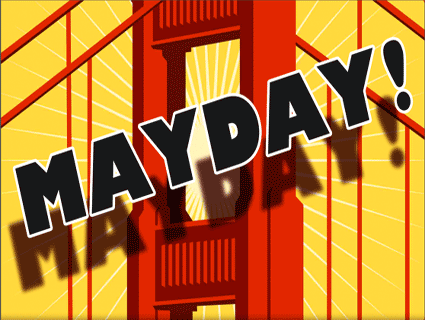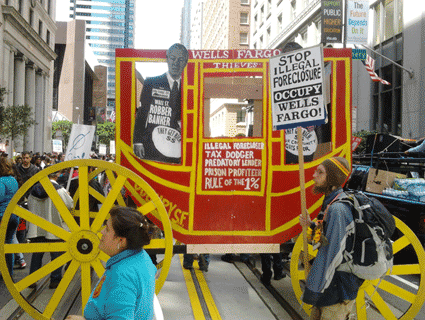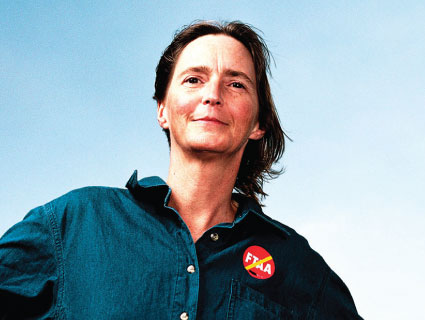
<a href="http://ggbridge.live2.radicaldesigns.org/fliers/">Occupy The Bridge</a>
Update 3/30/12: Unions have called off plans to shut down the Golden Gate Bridge
On the first of May, the Occupy Wall Street movement hopes to leverage the labor holiday known as May Day and muster enough people power to blockade the Golden Gate Bridge—assuming, that is, that striking bridge workers take the lead. “We can’t do an action for them; we have to do the action with them,” says Lauren Smith, a spokeswoman for Occupy Oakland. An union organizer for the bridge workers had no comment on their plans, but alluded to something big: “Our actions are going to speak louder than words.”
While the presumptive bridge protest is just one among dozens of demonstrations being planned for 40 cities on May 1, it illustrates how the movement is simultaneously getting bolder and more strategic in its bid to remain a relevant part of the national conversation. Occupy organizers promise that Tuesday will be bigger than anything we saw from the movement last fall. “May Day will be the big kickoff of Phase 2 of Occupy,” says Marissa Holmes, an early OWS organizer. “I think we will see a lot of people in the streets taking more militant actions than they had in the past.” But bringing out the numbers—and rebooting a movement that has largely faded from the headlines—will require a greater level of partnership with organized labor and kindred protest movements.
May Day, or International Workers Day, is a national holiday in many parts of Asia, Europe, and Latin America, but it hasn’t been observed in the United States for years due to its historical association with the Communist Party. The exception was 2006, when hundreds of thousands of low-wage workers joined “A Day Without Immigrants,” a one-day boycott of schools and businesses to protest US immigration policies.
Los Angeles was the epicenter of those protests, and it was that city’s Occupy activists who first suggested reviving May Day—this time with a call for a general strike. The major Occupy groups have endorsed the plan, though national labor unions haven’t—a symptom of their political cautiousness but also the prevalence of labor contracts that contain “no strike” clauses.
I spoke with some academics who question whether a general strike (which Occupy Oakland attempted last fall), or a bridge shutdown (which was tried in New York), make much sense for the movement at this stage. “Tactics don’t remain effective—and especially when you are dealing with a huge issue like they are,” says Michael Kazin, a Georgetown University professor who studies social movements.
In Kazin’s view, the closest historical precedent to Occupy is the anti-monopoly movement of the late 19th century, when socialists, anarchists, and populist reformers united to bust the trusts. Much as Occupy has embraced social media and live-streaming, the anti-monopolists published hundreds of independent newspapers. But, Kazin adds, they also worked to elect sympathetic politicians. “I think history teaches that when people to the left of liberals are able to advance is when you have people who at least talk about reform in power,” he says.
“Occupy needs to play a part in electoral politics, it needs to work outside electoral politics, it needs to be a thousand-ring circus,” says Columbia University journalism professor Todd Gitlin, a 1960s-era president of Students for a Democratic Society and author of the forthcoming book Occupy Nation. (Gitlin has also written for Mother Jones.) He worries that occupiers are overly paranoid about being co-opted by would-be allies in the political realm. For example, Adbusters, the magazine whose call for protest sparked Occupy Wall Street, recently blamed the 99% Spring—an activist training effort led by groups like MoveOn.org and the Service Employees International Union (SEIU)—for “the derailment of our movement.” (Click here to read my piece on the 99% Spring, in which I attended one of the training sessions.)
May Day could help mend those divides, as planning coalitions featuring dozens of labor, community, and immigrant-rights groups—including many 99% Spring organizers—have popped up in major cities. Holmes expects tens of thousands of people to turn out in New York City, where planning for May Day has been a major focus of Occupy this year. But that’s a drop in the bucket compared to the 500,000 residents and immigration activists who marched through downtown Los Angeles in March 2006, drawn by LA media personalities such as syndicated radio host Eddie “Piolín” Sotelo, who has not publicized this year’s protests.
“I think one way it gets bigger is that people understand how broad the reach of these banks and companies is,” says Stephen Lerner, an executive board member with the SEIU. Wells Fargo mutual funds, for instance, invest millions of dollars in the GEO Group and Corrections Corporation of America, private prison firms that profit from detaining immigrants. And Bank of America has been a major financier of coal-fired power plants—though new ones may be a thing of the past. Lerner hopes that May Day helps people realize that “the same forces run everything, and we can join forces in targeting them.”
Of course, not everybody agrees on how to do that. Take the Golden Gate Bridge occupation, which would nominally be in support of 375 bridge mechanics, ferry captains, and bus drivers who face a steep increase in health care costs: “Obviously, it is an incredible action, the whole idea of it,” argues Occupy Oakland’s Smith. Gitlin, the former SDS president, worries that blocking the bridge might incite road rage against the protesters. And then there’s the man the Washington Post calls “arguably the most influential living historian of American labor,” UC-Santa Barbara’s Nelson Lichtenstein. “I guess I would say, sitting in my armchair here at age 67, that yeah, I hope they do shut down the bridge,” Lichtenstein says. “The liberals and the Obama-ites and whoever else, they are looking for a sense that this chronic recession is generating a sense of crisis.”
Whatever happens on the bridge, it represents an evolution for Occupy Oakland, one of the most energetic but least disciplined Occupy chapters. Since January, when confrontational protests in Oakland led to 400 arrests, the Occupy group has held BBQs and street cleanups in city neighborhoods to rebuild trust. Smith wants the bridge occupation to send a clearer message than past protests. “The reason we are being a little more cautious,” she says, “is we want to prevent the waters from being murky this time.”















